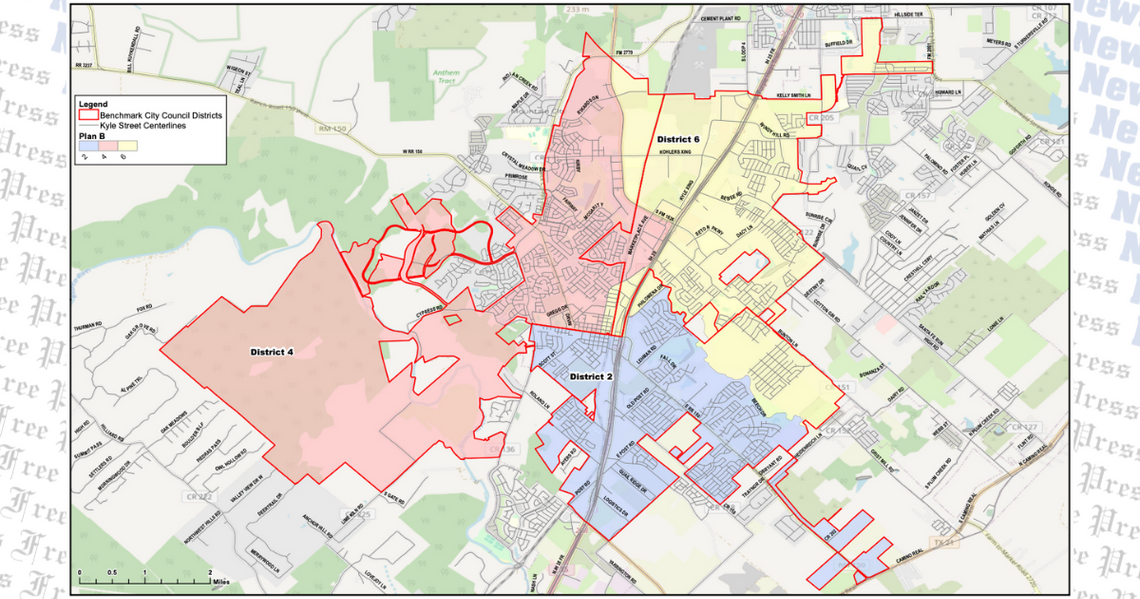KYLE — Residents may be under new representation, following the latest discussions to redraw the boundary lines for single-member districts in Kyle.
Kyle City Council discussed potential redistricting, as it was previously more than double the constitutional deviation between districts, at its April 15 meeting.
“This item is a continuation of an item we’ve been discussing for probably close to a year at this point on the redistricting of the city council districts,” said city attorney Aimee Alcorn-Reed, who presented map Plan B, which was suggested by council at the March 29 special meeting.
According to agenda documents, council initially approved an agreement with Bickerstaff Heath Delgado Acosta LLP in June 2024 for the evaluation of the need to realign single-member districts. Later that year, in November, Cobby Caputo of Bickerstaff presented an initial Plan A, to which council responded that he should take into account the growth of the city since the 2020 census, which is what the data was based on.
His presentation March 4 noted that the city is growing uniformly, with only districts four and six slightly moving past district two.
According to agenda documents, the proposed map would increase the population in district four by 6.18%, while districts two and six would decrease by 3.28% and 2.90%, respectively.
“[This map] meets all the criteria that I have. I can support and defend this Plan B, whether it’s the best plan for Kyle is, of course, for you all to decide,” said Caputo.
Council member Robert Rizo, who was not at the March 29 special meeting, stated that he is not a fan of the new map, as the district numbers and representation change dramatically.
Despite the prediction of growth in district six, said council member Michael Tobias, who was also physically absent from the March 29 meeting and experienced technical difficulties, this could be years into the future and will not match the representation of the district today: “I’m not in a hurry to change this right off the bat.”
Along with these concerns, he asked whether there was a possibility of an open house to receive community feedback.
Legally, said Caputo, the changes to the districts need to be made from what it is now, whether Plan A or Plan B, because “there can be no more than a 10% deviation from the largest district to the smallest district and y’all ended up — I don’t have it right here in front of me right now — but it was somewhere around 20%. So, you were more than two times the constitutional standard.”
“There was a lot of data that went into structuring these and a lot of discussion about keeping neighborhoods intact. In district four, Spring Branch and Silverado, which had been split, now are intact. We [also] talked about the growth in district two and district six, which actually, surprisingly is greater than district four. I think that they did a great job in balancing those needs,” said council member Lauralee Harris.
She also stated that if council were to move forward with this plan, each district would now have ownership of a portion of downtown Kyle, promoting interest.
“I just don’t see population numbers adding up when those changes are so big … I can understand district four wanting a little bit of the downtown, but actually, I think district two should have more of downtown more than anything because it’s the original district there. I’m not real comfortable with that,” Rizo responded. “It’s the size of the population [that] I’m worried about … It just doesn’t make sense to me.”
“While the numbers of district four [are] slightly larger in terms of population, it is within standard deviation and the other districts, in theory, based on the growth of the approved developments, some of which are already being built, the populations will catch up,” said Mayor Pro Tem Bear Heiser.
Mayor Travis Mitchell was absent from the meeting.
Kyle City Council will meet next May 6; however, the item will come before council at its May 27 meeting for further discussion.










